Scotland
| Motto: In My Defens God Me Defend (Scots) (Often shown abbreviated as IN DEFENS) | |
| Anthem: None (de jure) Flower of Scotland, Scotland the Brave (de facto) | |
 | |
| Capital | Edinburgh |
| Largest city | Glasgow |
| Official languages | English (de facto)1 |
| Recognised regional languages | Gaelic, Scots |
| Ethnic groups | 88% Scottish, 8% English, Irish, Welsh, 4% other[1] |
| Demonym(s) | Scottish2 |
| Government | Constitutional monarchy |
• Monarch | Elizabeth II |
| Alex Salmond MP MSP | |
| Gordon Brown | |
| Legislature | Scottish Parliament |
| Establishment Early Middle Ages; exact date of establishment unclear or disputed; traditional 843, by King Kenneth MacAlpin[2] | |
| Area | |
• Total | 78,772 km2 (30,414 sq mi) |
• Water (%) | 1.9 |
| Population | |
• 2007 estimate | 5,144,200 |
• 2001 census | 5,062,011 |
• Density | 65/km2 (168.3/sq mi) |
| GDP (PPP) | 2006 estimate |
• Total | US$194 billion[citation needed] |
• Per capita | US$39,680[citation needed] |
| HDI (2003) | 0.939 very high |
| Currency | Pound sterling (GBP) |
| Time zone | UTC0 (GMT) |
• Summer (DST) | UTC+1 (BST) |
| Calling code | 44 |
| ISO 3166 code | GB-SCT |
| Internet TLD | .uk3 |
| |
Scotland (Gaelic: Alba) is a country that is part of the United Kingdom.[6][7][8] Occupying the northern third of the island of Great Britain, it shares a border with England to the south and is bounded by the North Sea to the east, the Atlantic Ocean to the north and west, and the North Channel and Irish Sea to the southwest. In addition to the mainland, Scotland consists of over 790 islands[9] including the Northern Isles and the Hebrides.
Edinburgh, the country's capital and second largest city, is one of Europe's largest financial centres.[10][11][12] It was the hub of the Scottish Enlightenment of the 18th century, which saw Scotland become one of the commercial, intellectual and industrial powerhouses of Europe. Scotland's largest city is Glasgow, which was once one of the world's leading industrial metropolises, and now lies at the centre of the Greater Glasgow conurbation which dominates the Scottish Lowlands. Scottish waters consist of a large sector[13] of the North Atlantic and the North Sea, containing the largest oil reserves in the European Union.
The Kingdom of Scotland was an independent state until 1 May 1707 when it joined in a political union with the Kingdom of England to create a united Kingdom of Great Britain.[14][15] This union was the result of the Treaty of Union agreed in 1706 and put into effect by the Acts of Union that were passed by the Parliaments of both countries despite widespread protest across Scotland.[16][17] Scotland's legal system continues to be separate from those of England, Wales, and Northern Ireland and Scotland still constitutes a distinct jurisdiction in public and in private law.[18] The continued independence of Scots law, the Scottish education system, and the Church of Scotland have all contributed to the continuation of Scottish culture and Scottish national identity since the Union.[19] Although Scotland is no longer a separate sovereign state, the constitutional future of Scotland continues to give rise to debate.
Etymology
Scotland is from the Latin Scoti, the term applied to Gaels. The Late Latin word Scotia (land of the Gaels) was initially used to refer to Ireland. By the 11th century at the latest, Scotia was being used to refer to (Gaelic-speaking) Scotland north of the river Forth, alongside Albania or Albany, both derived from the Gaelic Alba.[20] The use of the words Scots and Scotland to encompass all of what is now Scotland became common in the Late Middle Ages.[14]
History

Early history
Repeated glaciations, which covered the entire land-mass of modern Scotland, have destroyed any traces of human habitation that may have existed before the Mesolithic period. It is believed that the first post-glacial groups of hunter-gatherers arrived in Scotland around 12,800 years ago, as the ice sheet retreated after the last glaciation.[21][22] Groups of settlers began building the first known permanent houses on Scottish soil around 9,500 years ago, and the first villages around 6,000 years ago. The well-preserved village of Skara Brae on the Mainland of Orkney dates from this period. Neolithic habitation, burial and ritual sites are particularly common and well-preserved in the Northern Isles and Western Isles, where lack of trees led to most structures being built of local stone.[23]
Roman influence
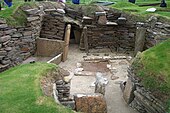
The written protohistory of Scotland began with the arrival of the Roman Empire in southern and central Great Britain, when the Romans occupied what is now England and Wales, administering it as a province called Britannia. Roman invasions and occupations of southern Scotland were a series of brief interludes. In 83–4 AD the general Gnaeus Julius Agricola defeated the Caledonians at the battle of Mons Graupius, and Roman forts were briefly set along the Gask Ridge close to the Highland line (none are known to have been constructed beyond that line). Three years after the battle the Roman armies had withdrawn to the Southern Uplands.[24] They erected Hadrian's Wall to control tribes on both sides of the wall,[25] and the Limes Britannicus became the northern border of the empire, although the army held the Antonine Wall in the Central Lowlands for two short periods—the last of these during the time of Emperor Septimius Severus from 208 until 210.[26] The extent of Roman military occupation of any significant part of Scotland was limited to a total of about 40 years, although their influence on the southern section of the country occupied by Brythonic tribes such as the Votadini and Damnonii would still have been considerable.[25]

Medieval period
The Kingdom of the Picts (based in Fortriu by the 6th century) was the state which eventually became known as "Alba" or "Scotland". The development of "Pictland", according to the historical model developed by Peter Heather, was a natural response to Roman imperialism.[27] Another view places emphasis on the Battle of Dunnichen, and the reign of Bridei m. Beli (671–693), with another period of consolidation in the reign of Óengus mac Fergusa (732–761).[28] The Kingdom of the Picts as it was in the early 8th century, when Bede was writing, was largely the same as the kingdom of the Scots in the reign of Alexander (1107–1124). However, by the tenth century, the Pictish kingdom was dominated by what we can recognise as Gaelic culture, and had developed an Irish conquest myth around the ancestor of the contemporary royal dynasty, Cináed mac Ailpín (Kenneth MacAlpin).[29][2][30]
From a base of territory in eastern Scotland north of the River Forth and south of the River Oykel, the kingdom acquired control of the lands lying to the north and south. By the 12th century, the kings of Alba had added to their territories the Anglic-speaking land in the south-east and attained overlordship of Gaelic-speaking Galloway and Norse-speaking Caithness; by the end of the 13th century, the kingdom had assumed approximately its modern borders. However, processes of cultural and economic change beginning in the 12th century ensured Scotland looked very different in the later Middle Ages. The stimulus for this was the reign of King David I and the Davidian Revolution. Feudalism, government reorganisation and the first legally defined towns (called burghs) began in this period. These institutions and the immigration of French and Anglo-French knights and churchmen facilitated a process of cultural osmosis, whereby the culture and language of the low-lying and coastal parts of the kingdom's original territory in the east became, like the newly acquired south-east, English-speaking, while the rest of the country retained the Gaelic language, apart from the Northern Isles of Orkney and Shetland, which remained under Norse rule until 1468.[31][32][33]
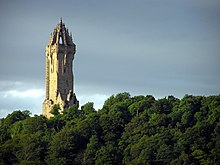
The death of Alexander III in March 1286, followed by the death of his granddaughter Margaret, Maid of Norway, broke the succession line of Scotland's kings. This led to the intervention of Edward I of England, who manipulated this period of confusion to have himself recognised as feudal overlord of Scotland. Edward organised a process to identify the person with the best claim to the vacant crown, which became known as the Great Cause, and this resulted in the enthronement of John Balliol as king. The Scots were resentful of Edward's meddling in their affairs and this relationship quickly broke down. War ensued and King John was deposed by his overlord, who took personal control of Scotland. Andrew Moray and William Wallace initially emerged as the principal leaders of the resistance to English rule in what became known as the Wars of Scottish Independence. The nature of the struggle changed dramatically when Robert de Brus, Earl of Carrick, became king (as Robert I). War with England continued for several decades, and a civil war between the Bruce dynasty and their long-term Comyn-Balliol rivals, the flashpoint of which could be traced to the slaying in a Dumfries church of John 'the Red' Comyn of Badenoch by Bruce and his supporters, lasted until the middle of the 14th century. Although the Bruce dynasty was successful, David II's lack of an heir allowed his nephew Robert II to come to the throne and establish the Stewart Dynasty.[34][32] The Stewarts ruled Scotland for the remainder of the Middle Ages. The country they ruled experienced greater prosperity from the end of the 14th century through the Scottish Renaissance to the Reformation. This was despite continual warfare with England, the increasing division between Highlands and Lowlands, and a large number of royal minorities.[34][35]
Modern history
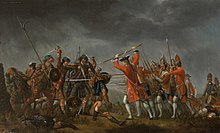
In 1603, James VI King of Scots inherited the throne of the Kingdom of England, and became King James I of England, and left Edinburgh for London.[36] With the exception of a short period under the Protectorate, Scotland remained a separate state, but there was considerable conflict between the crown and the Covenanters over the form of church government. After the Glorious Revolution, the abolition of episcopacy and the overthrow of the Roman Catholic James VII by William and Mary, Scotland briefly threatened to select a different Protestant monarch from England.[37] On 22 July 1706 the Treaty of Union was agreed between representatives of the Scots Parliament and the Parliament of England and the following year twin Acts of Union were passed by both parliaments to create the united Kingdom of Great Britain with effect from 1 May 1707.[15]
The deposed Jacobite Stuart claimants had remained popular in the Highlands and north-east, particularly amongst non-Presbyterians. However, two major Jacobite risings launched in 1715 and 1745 failed to remove the House of Hanover from the British throne. The threat of the Jacobite movement to the United Kingdom and its monarchs effectively ended at the Battle of Culloden, Great Britain's last pitched battle. This defeat paved the way for large-scale removals of the indigenous populations of the Highlands and Islands, known as the Highland Clearances.[15]
The Scottish Enlightenment and the Industrial Revolution made Scotland into an intellectual, commercial and industrial powerhouse.[citation needed] After World War II, Scotland experienced an industrial decline which was particularly severe.[38] Only in recent decades has the country enjoyed something of a cultural and economic renaissance. Economic factors which have contributed to this recovery include a resurgent financial services industry, electronics manufacturing, (see Silicon Glen),[39] and the North Sea oil and gas industry.[40]
Following a referendum on devolution proposals in 1997, the Scotland Act 1998[41] was passed by the United Kingdom Parliament to establish a devolved Scottish Parliament.
Government and politics
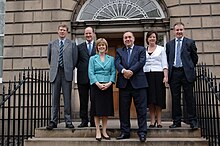
Scotland's head of state is the monarch of the United Kingdom, currently Queen Elizabeth II (since 1952). The title Elizabeth II caused controversy around the time of the queen's coronation, as there had never been an Elizabeth I in Scotland. A legal case, MacCormick v. Lord Advocate (1953 SC 396), was taken to contest the right of the Queen to title herself Elizabeth II within Scotland, arguing that to do so would be a breach of Article 1 of the Treaty of Union. The case was lost and it was decided that future British monarchs would be numbered according to either their English or Scottish predecessors, whichever number is higher;[42]
Scotland has limited self-government within the United Kingdom as well as representation in the UK Parliament. Executive and legislative powers have been devolved to, respectively, the Scottish Government and the Scottish Parliament at Holyrood in Edinburgh. The United Kingdom Parliament retains power over a set list of areas explicitly specified in the Scotland Act 1998 as reserved matters, including, for example, levels of UK taxes, social security, defence, international relations and broadcasting,[43] with all other matters being devolved.
The Scottish Parliament has legislative authority for all other areas relating to Scotland, as well as limited power to vary income tax, a power it has yet to exercise. The Scottish Parliament can give legislative consent over devolved matters back to Westminster by passing a Legislative Consent Motion if United Kingdom-wide legislation is considered to be more appropriate for a certain issue. The programmes of legislation enacted by the Scottish Parliament have seen a divergence in the provision of public services compared to the rest of the United Kingdom. For instance, the costs of a university education, and care services for the elderly are free at point of use in Scotland, while fees are paid in the rest of the UK. Scotland was the first country in the UK to ban smoking in enclosed public places.[44]
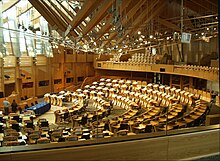
The Scottish Parliament is a unicameral legislature comprising 129 Members, 73 of whom represent individual constituencies and are elected on a first past the post system; 56 are elected in eight different electoral regions by the additional member system, serving for a four year period. The Queen appoints one Member of the Scottish Parliament, (MSP), on the nomination of the Parliament, to be First Minister. Other Ministers are also appointed by the Queen on the nomination of the Parliament and together with the First Minister they make up the Scottish Government, the executive arm of government.[45]

In the 2007 election, the Scottish National Party (SNP), which campaigns for Scottish independence, won the largest number of seats of any single party and the leader of the SNP, Alex Salmond, was elected First Minister on 16 May 2007 as head of a minority government. The Labour Party became the largest opposition party, with the Conservative Party, the Liberal Democrats, and the Green Party are also represented in the Parliament. Margo MacDonald is the only independent MSP sitting in Parliament.[46]
Scotland is represented in the British House of Commons by 59 MPs elected from territory-based Scottish constituencies. The Scotland Office represents the UK government in Scotland on reserved matters and represents Scottish interests within the UK government.[47] The Scotland office is led by the Secretary of State for Scotland, who sits in the Cabinet of the United Kingdom, the current incumbent being Jim Murphy.[43]
Administrative subdivisions

Historical types subdivisions of Scotland include the mormaerdom, stewartry, earldom, burgh, parish, county and regions and districts. The names of these areas are still sometimes used as geographical descriptors.
Modern Scotland is subdivided in various ways depending on the purpose. For local government, there have been 32 council areas since 1996,[48] whose councils are unitary authorities responsible for the provision of all local government services. Community councils are informal organisations that represent specific sub-divisions of a council area.
For the Scottish Parliament, there are 73 constituencies and eight regions. For the Parliament of the United Kingdom, there are 59 constituencies. The Scottish fire brigades and police forces are still based on the system of regions introduced in 1975. For healthcare and postal districts, and a number of other governmental and non-governmental organisations such as the churches, there are other long-standing methods of subdividing Scotland for the purposes of administration.
City status in the United Kingdom is determined by letters patent.[49] There are six cities in Scotland: Aberdeen, Dundee, Edinburgh, Glasgow, most recently Inverness, and Stirling.[50]
Scotland within the UK
A policy of devolution had been advocated by the three main UK parties with varying enthusiasm during recent history. Ex-Labour-leader John Smith described the revival of a Scottish parliament as the "settled will of the Scottish people".[51] The constitutional status of Scotland is nonetheless subject to ongoing debate. In 2007, the Scottish Government established a "National Conversation" on constitutional issues, proposing a number of options such as increasing the powers of the Scottish Parliament, federalism, or a referendum on Scottish independence from the United Kingdom. In rejecting the last option, the three main opposition parties in the Scottish Parliament have proposed a separate Scottish Constitutional Commission to investigate the distribution of powers between devolved Scottish and UK-wide bodies.[52]
Law and criminal justice

Scots law has a basis derived from Roman law,[53] combining features of both uncodified civil law, dating back to the Corpus Juris Civilis, and common law with medieval sources. The terms of the Treaty of Union with England in 1707 guaranteed the continued existence of a separate legal system in Scotland from that of England and Wales.[54] Prior to 1611, there were several regional law systems in Scotland, most notably Udal law in Orkney and Shetland, based on old Norse law. Various other systems derived from common Celtic or Brehon laws survived in the Highlands until the 1800s.[55]
Scots law provides for three types of courts responsible for the administration of justice: civil, criminal and heraldic. The supreme civil court is the Court of Session, although civil appeals can be taken to the House of Lords. The High Court of Justiciary is the supreme criminal court. Both courts are housed at Parliament House, in Edinburgh, which was the home of the pre-Union Parliament of Scotland. The sheriff court is the main criminal and civil court. There are 49 sheriff courts throughout the country.[56] District courts were introduced in 1975 for minor offences. The Court of the Lord Lyon regulates heraldry.
The Scots legal system is unique in having three possible verdicts for a criminal trial: "guilty", "not guilty" and "not proven". Both "not guilty" and "not proven" result in an acquittal with no possibility of retrial.[57]
Scots juries consist of fifteen, not twelve jurors as is more common in English-speaking countries.
The Scottish Prison Service (SPS) manages the prisons in Scotland which contain between them over 7,500 prisoners.[58] The Cabinet Secretary for Justice is responsible for the Scottish Prison Service within the Scottish Government.
Geography and natural history

The main land of Scotland comprises the northern third of the land mass of the island of Great Britain, which lies off the northwest coast of Continental Europe. The total area is 78,772 km² (30,414 sq mi),[59] comparable to the size of the Czech Republic, making Scotland the 117th largest country in the world.[citation needed] Scotland's only land border is with England, and runs for 96 kilometres (60 mi) between the basin of the River Tweed on the east coast and the Solway Firth in the west. The Atlantic Ocean borders the west coast and the North Sea is to the east. The island of Ireland lies only 30 kilometres (20 mi) from the southwestern peninsula of Kintyre;[60] Norway is 305 kilometres (190 mi) to the east and the Faroes, 270 kilometres (168 mi) to the north.

The territorial extent of Scotland is generally that established by the 1237 Treaty of York between Scotland and England[61] and the 1266 Treaty of Perth between Scotland and Norway.[15] Important exceptions include the Isle of Man, which having been lost to England in the 14th century is now a crown dependency outside of the United Kingdom; the island groups Orkney and Shetland, which were acquired from Norway in 1472;[59] and Berwick-upon-Tweed, lost to England in 1482.
The geographical centre of Scotland lies a few miles from the village of Newtonmore in Badenoch.[62] Rising to 1,344 metres (4,406 ft) above sea level, Scotland's highest point is the summit of Ben Nevis, in Lochaber, while Scotland's longest river, the River Tay, flows for a distance of 190 km (120 miles).[63][64]
Geology and geomorphology


The whole of Scotland was covered by ice sheets during the Pleistocene ice ages and the landscape is much affected by glaciation. From a geological perspective the country has three main sub-divisions. The Highlands and Islands lie to the north and west of the Highland Boundary Fault, which runs from Arran to Stonehaven. This part of Scotland largely comprises ancient rocks from the Cambrian and Precambrian which were uplifted during the later Caledonian Orogeny. It is interspersed with igneous intrusions of a more recent age, the remnants of which have formed mountain massifs such as the Cairngorms and Skye Cuillins. A significant exception to the above are the fossil-bearing beds of Old Red Sandstones found principally along the Moray Firth coast. The Highlands are generally mountainous and the highest elevations in the British Isles are found here. Scotland has over 790 islands, divided into four main groups: Shetland, Orkney, and the Inner Hebrides and Outer Hebrides. There are numerous bodies of freshwater including Loch Lomond and Loch Ness. Some parts of the coastline consist of machair, a low lying dune pasture land.
The Central Lowlands is a rift valley mainly comprising Paleozoic formations. Many of these sediments have economic significance for it is here that the coal and iron bearing rocks that fuelled Scotland's industrial revolution are to be found. This area has also experienced intense volcanism, Arthur’s Seat in Edinburgh being the remnant of a once much larger volcano. This area is relatively low-lying, although even here hills such as the Ochils and Campsie Fells are rarely far from view.
The Southern Uplands are a range of hills almost 200 kilometres (125 mi) long, interspersed with broad valleys. They lie south of a second fault line (the Southern Uplands fault) that runs from the Rhinns of Galloway to Dunbar.[65] The geological foundations largely comprise Silurian deposits laid down some 4–500 million years ago. The high point of the Southern Uplands is Merrick with an elevation of 843 m (2,766 ft).[14][66][67][68]
Climate

The climate of Scotland is temperate and oceanic, and tends to be very changeable. It is warmed by the Gulf Stream from the Atlantic, and as such has much milder winters (but cooler, wetter summers) than areas on similar latitudes, for example Copenhagen, Moscow, or the Kamchatka Peninsula on the opposite side of Eurasia. However, temperatures are generally lower than in the rest of the UK, with the coldest ever UK temperature of -27.2 °C (-16.96 °F) recorded at Braemar in the Grampian Mountains, on 11 February 1895.[69] Winter maximums average 6 °C (42.8 °F) in the lowlands, with summer maximums averaging 18 °C (64.4 °F). The highest temperature recorded was 32.9 °C (91.22 °F) at Greycrook, Scottish Borders on 9 August 2003.[70]
In general, the west of Scotland is usually warmer than the east, owing to the influence of Atlantic ocean currents and the colder surface temperatures of the North Sea. Tiree, in the Inner Hebrides, is one of the sunniest places in the country: it had 300 days of sunshine in 1975. Rainfall varies widely across Scotland. The western highlands of Scotland are the wettest place, with annual rainfall exceeding 3,000 mm (120 in).[70] In comparison, much of lowland Scotland receives less than 800 mm (31 in) annually.[70] Heavy snowfall is not common in the lowlands, but becomes more common with altitude. Braemar experiences an average of 59 snow days per year,[71] while coastal areas have an average of fewer than 10 days.[70]
Flora and fauna

Scotland's wildlife is typical of the north west of Europe, although several of the larger mammals such as the Lynx, Brown Bear, Wolf, Elk and Walrus were hunted to extinction in historic times. There are important populations of seals and internationally significant nesting grounds for a variety of seabirds such as Gannets.[72] The Golden Eagle is something of a national icon.

On the high mountain tops species including Ptarmigan, Mountain Hare and Stoat can be seen in their white colour phase during winter months.[73] Remnants of native Scots Pine forest exist[74] and within these areas the Scottish Crossbill, Britain's only endemic bird, can be found alongside Capercaillie, Wildcat, Red Squirrel and Pine Marten.[75][76]
The flora of the country is varied incorporating both deciduous and coniferous woodland and moorland and tundra species. However, large scale commercial tree planting and the management of upland moorland habitat for the grazing of sheep and commercial field sport activities impacts upon the distribution of indigenous plants and animals.[77] The UK's tallest tree is a Douglas Fir located in Reelig Glen near Inverness, and the Fortingall Yew may be 5,000 years old and is probably the oldest living thing in Europe.[78][79] Although the number of native vascular plants is low by world standards, Scotland's substantial bryophyte flora is of global importance.[80][81]
Economy and infrastructure

Scotland has a western style open mixed economy which is closely linked with that of the rest of Europe and the wider world. Traditionally, the Scottish economy has been dominated by heavy industry underpinned by the shipbuilding in Glasgow, coal mining and steel industries. Petroleum related industries associated with the extraction of North Sea oil have also been important employers from the 1970s, especially in the north east of Scotland. De-industrialisation during the 1970s and 1980s saw a shift from a manufacturing focus towards a more service-oriented economy. Edinburgh is the financial services centre of Scotland and the sixth largest financial centre in Europe in terms of funds under management, behind London, Paris, Frankfurt, Zurich and Amsterdam,[82] with many large finance firms based there, including: the Royal Bank of Scotland (the second largest bank in Europe); HBOS (owners of the Bank of Scotland); and Standard Life.

In 2005, total Scottish exports (excluding intra-UK trade) were provisionally estimated to be £17.5 billion, of which 70% (£12.2 billion) were attributable to manufacturing.[83] Scotland's primary exports include whisky, electronics and financial services. The United States, The Netherlands, Germany, France and Spain constitute the country's major export markets.[83] In 2006, the Gross Domestic Product (GDP) of Scotland (excluding oil and gas production from 'Scottish' waters) was just over £86 billion, giving a per capita GDP of £16,900.[84][85]
Tourism is widely recognised as a key contributor to the Scottish economy. A briefing published in 2002 by the Scottish Parliament Information Centre, (SPICe), for the Scottish Parliament's Enterprise and Life Long Learning Committee, stated that tourism accounted for up to 5% of GDP and 7.5% of employment.[86]
As of November 2007 the unemployment rate in Scotland stood at 4.9%—lower than the UK average and that of the majority of EU countries.[87]
The most recent government figures (for 2006/7) suggest that Scotland would be in budget surplus to the tune of more than £800m if it received its geographical share of North Sea revenues.[88] The net fiscal balance, which is the budget balance plus capital investment, reported a deficit of £2.7 billion (2.1% of GDP) including Scotland's full geographical share of North Sea revenue, or a £10.2bn deficit if the North Sea share is excluded.[89]
Currency
Although the Bank of England is the central bank for the UK, three Scottish clearing banks still issue their own Sterling banknotes: the Bank of Scotland; the Royal Bank of Scotland; and the Clydesdale Bank. The current value of the Scottish banknotes in circulation is £1.5 billion.[90]
Transport
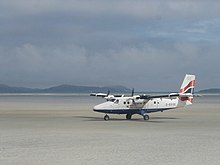
Scotland has five main international airports (Glasgow International, Edinburgh, Aberdeen, Glasgow Prestwick and Inverness) which together serve 150 international destinations with a wide variety of scheduled and chartered flights.[91] BAA operates three airports, (Edinburgh, Glasgow and Aberdeen), and Highland and Islands Airports operates 11 regional airports, (including Inverness), which serve the more remote locations of Scotland.[92] Infratil operates Glasgow Prestwick.
The Scottish motorways and major trunk roads are managed by Transport Scotland. The rest of the road network is managed by the Scottish local authorities in each of their areas.
Regular ferry services operate between the Scottish mainland and island communities. These services are mostly run by Caledonian MacBrayne, but some are operated by local councils. Other ferry routes, served by multiple companies, connect to Northern Ireland, Belgium, Norway, the Faroe Islands and also Iceland.
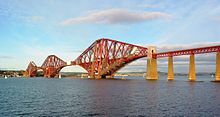
Network Rail Infrastructure Limited owns and operates the fixed infrastructure assets of the railway system in Scotland, while the Scottish Government maintains overall responsibility for rail strategy and funding in Scotland.[93] Scotland’s rail network has around 340 railway stations and 3,000 kilometres of track with over 62 million passenger journeys made each year.[94]
Scotland's rail network is managed by Transport Scotland.[95] The East Coast and West Coast Main Railway lines and the Cross Country Line connect the major cities and towns of Scotland with each other and with the rail network in England. Domestic rail services within Scotland are operated by First ScotRail.
The East Coast Main Line includes that section of the network which crosses the Firth of Forth via the Forth Bridge. Completed in 1890, this cantilever bridge has been described as "the one internationally recognised Scottish landmark".[96]
Demography

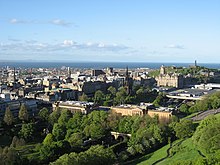
The population of Scotland in the 2001 census was 5,062,011. This has risen to 5,116,900 according to June 2006 estimates.[97] This would make Scotland the 112th largest country by population if it were a sovereign state. Although Edinburgh is the capital of Scotland it is not the largest city. With a population of just over 600,000 this honour falls to Glasgow. Indeed, the Greater Glasgow conurbation, with a population of over 1.1 million, is home to over a fifth of Scotland's population.[98][99]
The Central Belt is where most of the main towns and cities are located. Glasgow is to the west, while Edinburgh and Dundee lie on the east coast. Scotland's only major city outside the Central Belt is Aberdeen, on the east coast to the north. Apart from Aberdeen, the Highlands are sparsely populated, although the city of Inverness has experienced rapid growth in recent years. In general only the more accessible and larger islands retain human populations, and fewer than 90 are currently inhabited. The Southern Uplands are essentially rural in nature and dominated by agriculture and forestry.[100][101] Because of housing problems in Glasgow and Edinburgh, five new towns were created between 1947 and 1966. They are East Kilbride, Glenrothes, Livingston, Cumbernauld, and Irvine.[102]
Due to immigration since World War II, Glasgow, Edinburgh and Dundee have small Asian communities.[103] Since the recent Enlargement of the European Union there has been an increased number of people from Central and Eastern Europe moving to Scotland, and it is estimated that between 40,000 and 50,000 Poles are now living in the country.[104] As of 2001, there are 16,310 ethnic Chinese residents in Scotland.[105] The ethnic groups within Scotland are as follows: White - 97.99%, South Asian - 1.09%, Black - 0.16%, Mixed - 0.25%, Chinese - 0.32% and Other - 0.19%.
Scotland has three officially recognised languages: English, Scots and Scottish Gaelic. Almost all Scots speak Scottish Standard English, and in 1996 the General Register Office for Scotland estimated that 30% of the population are fluent in Scots.[106] Gaelic is mostly spoken in the Western Isles, where a majority of people still speak it; however, nationally its use is confined to just 1% of the population.[107]
Education
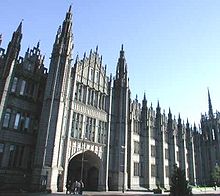
The Scottish education system has always remained distinct from education in the rest of United Kingdom, with a characteristic emphasis on a broad education.[108] Scotland was the first country since Sparta in classical Greece to implement a system of general public education.[109] Schooling was made compulsory for the first time in Scotland with the Education Act of 1496, then, in 1561, the Church of Scotland set out a national programme for spiritual reform, including a school in every parish. Education continued to be a matter for the church rather than the state until the Education Act of 1872.[110]
All 3 and 4 year old children in Scotland are entitled to a free nursery place with "a curriculum framework for children 3–5"[111] providing the curricular guidelines. Formal primary education begins at approximately 5 years old and lasts for 7 years (P1–P7); The "5–14 guidelines" provides the curricular framework.[112] Today, children in Scotland sit Standard Grade, or more recently Intermediate exams at approximately 15 or 16. The school leaving age is 16, after which students may choose to remain at school and study for Access, Intermediate or Higher Grade and Advanced Higher exams. A small number of students at certain private, independent schools may follow the English system and study towards GCSEs and A and AS-Levels instead.[113]
There are 14 Scottish universities, some of which are amongst the oldest in the world.[114][115] The country produces 1% of the world's published research with less than 0.1% of the world's population, and higher education institutions account for nine per cent of Scotland's service sector exports.[116][117]
Religion

Just over two-thirds (67%) of the Scottish population reported having a religion in 2001 with Christianity representing all but 2% of these.[118] 28% of the population claimed to have no religious adherence. This means that the non-religious are second in total numbers only to the numbers claimed by the Church of Scotland. As only 12% of the population are actually members of the Church of Scotland this means that the actively non-religious now out number the actively religious by 3 to 1.
Since the Scottish Reformation of 1560, the national church (the Church of Scotland, also known as The Kirk) has been Protestant and Reformed in theology. Since 1689 it has had a Presbyterian system of church government, and enjoys independence from the state.[14] About 12% of the population are currently members of the Church of Scotland, with 40% claiming affinity. The Church operates a territorial parish structure, with every community in Scotland having a local congregation. Scotland also has a significant Roman Catholic population, particularly in the west. After the Reformation, Roman Catholicism continued in the Highlands and some western islands like Uist and Barra, and was strengthened, during the 19th century by immigration from Ireland. Other Christian denominations in Scotland include the Free Church of Scotland, various other Presbyterian offshoots, and the Scottish Episcopal Church. Islam is the largest non-Christian religion (estimated at around 40,000, which is less than 0.9% of the population),[119] and there are also significant Jewish, Hindu and Sikh communities, especially in Glasgow.[119] The Samyé Ling monastery near Eskdalemuir, which celebrated its 40th anniversary in 2007, includes the largest Buddhist temple in western Europe.[120]
Healthcare
Healthcare in Scotland is mainly provided by NHS Scotland, Scotland's public healthcare system. The service was founded by the National Health Service (Scotland) Act 1947 (later repealed by the National Health Service (Scotland) Act 1978) that took effect on 5 July 1948 to coincide with the launch of the NHS in England and Wales. However, even prior to 1948, half of Scotland's landmass was already covered by state funded healthcare, provided by the Highlands and Islands Medical Service.[121] In 2006, NHS Scotland employed around 158,000 staff including more than 47,500 nurses, midwives and health visitors and over 3,800 consultants. In addition, there were also more than 12,000 doctors, family practitioners and allied health professionals, including dentists, opticians and community pharmacists, who operate as independent contractors providing a range of services within the NHS in return for fees and allowances.[122] The Cabinet Secretary for Health and Wellbeing is responsible to the Scottish Parliament for the work of NHS Scotland.
Military
Although Scotland has a long military tradition that predates the Treaty of Union with England, its armed forces now form part of the British Armed Forces, with the notable exception of the Atholl Highlanders, Europe's only legal private army. In 2006, the infantry regiments of the Scottish Division were amalgamated to form the Royal Regiment of Scotland. Other distinctively Scottish regiments in the British Army include the Scots Guards and Royal Scots Dragoon Guards.
Due to their topography and perceived remoteness, parts of Scotland have housed many sensitive defence establishments, with mixed public feelings.[123][124][125] Between 1960 and 1991, the Holy Loch was a base for the U.S. fleet of Polaris ballistic missile submarines.[126] Today, Her Majesty's Naval Base Clyde, 25 miles (40 km) west of Glasgow, is the base for the four Trident-armed Vanguard class ballistic missile submarines that comprise the UK's nuclear deterrent.
Three frontline Royal Air Force bases are also located in Scotland. These are RAF Lossiemouth, RAF Kinloss and RAF Leuchars, the last of which is the most northerly air defence fighter base in the United Kingdom.
The only open-air live depleted uranium weapons test range in the British Isles is located near Dundrennan.[127] As a result, over 7000 radioactive munitions lie on the seabed of the Solway Firth.[128]
Culture
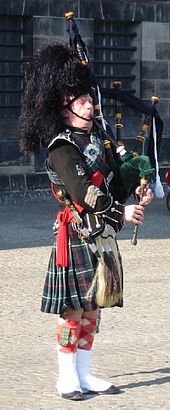
Scottish music is a significant aspect of the nation's culture, with both traditional and modern influences. A famous traditional Scottish instrument is the Great Highland Bagpipe, a wind instrument consisting of three drones and a melody pipe (called the chanter), which are fed continuously by a reservoir of air in a bag. Bagpipe bands, featuring bagpipes and various types of drums, and showcasing Scottish music styles while creating new ones, have spread throughout the world. The clàrsach (harp), fiddle and accordion are also traditional Scottish instruments, the latter two heavily featured in Scottish country dance bands. Today, there are many successful Scottish bands and individual artists in varying styles.[129]
Scottish literature includes text written in English, Scottish Gaelic, Scots, French, and Latin. The poet and songwriter Robert Burns wrote in the Scots language, although much of his writing is also in English and in a "light" Scots dialect which is more accessible to a wider audience. Similarly, the writings of Sir Walter Scott and Sir Arthur Conan Doyle were internationally successful during the late 19th and early 20th Centuries.[130] J. M. Barrie introduced the movement known as the "Kailyard school" at the end of the 19th century, which brought elements of fantasy and folklore back into fashion.[131] This tradition has been viewed as a major stumbling block for Scottish literature, as it focused on an idealised, pastoral picture of Scottish culture.[131] Some modern novelists, such as Irvine Welsh (of Trainspotting fame), write in a distinctly Scottish English that reflects the harsher realities of contemporary life.[132] More recently, author J.K. Rowling has become one of the most popular authors in the world (and one of the wealthiest) through her Harry Potter series, which she began writing from a coffee-shop in Edinburgh.
The national broadcaster is BBC Scotland (BBC Alba in Gaelic), a constituent part of the British Broadcasting Corporation, the publicly funded broadcaster of the United Kingdom. It runs two national television stations and the national radio stations, BBC Radio Scotland and BBC Radio nan Gaidheal, amongst others. The main Scottish commercial television stations are STV and Border Television. National newspapers such as the Daily Record, The Herald, and The Scotsman are all produced in Scotland.[133] Important regional dailies include The Courier in Dundee in the east, and The Press and Journal serving Aberdeen and the north.[133]
Sport
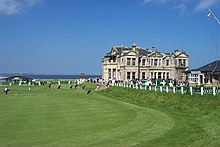
Sport is an important element in Scottish culture, with the country hosting many of its own national sporting competitions. It enjoys independent representation at many international sporting events including the FIFA World Cup, the Rugby Union World Cup, the Rugby League World Cup the Cricket World Cup and the Commonwealth Games, but it is not represented at the Olympic Games. Scotland has its own national governing bodies, such as the Scottish Football Association (the second oldest national football association in the world)[134] and the Scottish Rugby Union. Variations of football have been played in Scotland for centuries with the earliest reference dating back to 1424.[135] Association football is now the national sport and the Scottish Cup is the world's oldest national trophy.[136] Scottish clubs have been successful in European competitions with Celtic winning the European Cup in 1967, Rangers and Aberdeen winning the UEFA Cup Winners' Cup in 1972 and 1983 respectively, and Aberdeen also winning the UEFA Super Cup in 1983. The Fife town of St. Andrews is known internationally as the Home of Golf[137] and to many golfers the Old Course, an ancient links course dating to before 1574, is considered to be a site of pilgrimage.[138] There are many other famous golf courses in Scotland, including Carnoustie, Gleneagles, Muirfield and Royal Troon. Other distinctive features of the national sporting culture include the Highland games, curling and shinty. Scotland played host to the Commonwealth Games in 1970 and 1986, and will do so again in 2014.
National symbols
The national flag of Scotland, known as the Saltire or St. Andrew's Cross, dates (at least in legend) from the 9th century, and is thus the oldest national flag still in use. Since 1606 the Saltire has also formed part of the design of the Union Flag. There are numerous other symbols and symbolic artefacts, both official and unofficial, including the thistle, the nation's floral emblem, the 6 April 1320 statement of political independence the Declaration of Arbroath, the textile pattern tartan that often signifies a particular Scottish clan, and the Lion Rampant flag.[139][140][141]
Flower of Scotland is popularly held to be the National Anthem of Scotland, and is played at events such as football or rugby matches involving the Scotland national team. Scotland the Brave is used for the Scottish team at the Commonwealth Games. However, since devolution, more serious discussion of the issue has led to the use of Flower of Scotland being disputed. Other candidates include Highland Cathedral, Scots Wha Hae and A Man's A Man for A' That.[142]
St Andrew's Day, 30 November, is the national day, although Burns' Night tends to be more widely observed. Tartan Day is a recent innovation from Canada. In 2006, the Scottish Parliament passed the St. Andrew's Day Bank Holiday (Scotland) Act 2007, designating the day to be an official bank holiday.[143]
See also
References
- ^ Registrar-General's Mid-2005 Population Estimates for Scotland
- ^ a b Brown, Dauvit (2001). "Kenneth mac Alpin". In M. Lynch (ed.). The Oxford Companion to Scottish History. Oxford: Oxford University Press. p. 359. ISBN 978-0192116963.
- ^ "European Charter for Regional or Minority Languages" Scottish Government. Retrieved 27 September 2007.
- ^ Macleod, Angus "Gaelic given official status" (22 April 2005) The Times. London. Retrieved 2 August 2007.
- ^ "St Andrew—Quick Facts". Scotland.org—The Official Online Gateway. Retrieved 2007-12-02.
- ^ The Countries of the UK statistics.gov.uk, accessed 10 October, 2008
- ^ "Countries within a country". 10 Downing Street. Retrieved 2008-08-24.
The United Kingdom is made up of four countries: England, Scotland, Wales and Northern Ireland
- ^ "ISO 3166-2 Newsletter Date: 2007-11-28 No I-9. "Changes in the list of subdivision names and code elements" (Page 11)" (PDF). International Organization for Standardization codes for the representation of names of countries and their subdivisions -- Part 2: Country subdivision codes. Retrieved 2008-05-31.
SCT Scotland country
- ^ "Scottish Executive Resources" (PDF). Scotland in Short. Scottish Executive. 17 February 2007. Retrieved September 14.
{{cite web}}: Check date values in:|accessdate=(help); Unknown parameter|accessyear=ignored (|access-date=suggested) (help) - ^ "Global Financial Centres Index" (PDF). Retrieved 2008-09-07."Global Financial Centres Index 2007"
- ^ "The world's best financial cities". City Mayors Economics. Retrieved 2008-08-29.
- ^ "Economics in Scotland". Scottish Graduate Programme in Economics. Retrieved 2008-09-07.
- ^ "The Scottish Adjacent Waters Boundaries Order". London: The Stationery Office Limited. 1999. ISBN 0 11 059052 X. Retrieved 2007-09-20.
- ^ a b c d Keay, J. & Keay, J. (1994) Collins Encyclopaedia of Scotland. London. HarperCollins.
- ^ a b c d Mackie, J.D. (1969) A History of Scotland. London. Penguin.
- ^ Devine, T.M (1999). The Scottish Nation 1700–2000. Penguin Books. p. 9. ISBN 0140230041.
From that point on anti-union demonstrations were common in the capital. In November rioting spread to the south west, that stranglehold of strict Calvinism and covenanting tradition. The Glasgow mob rose against union sympathisers in disturbances which lasted intermittently for over a month
- ^ "Act of Union 1707 Mob unrest and disorder". London: The House of Lords. 2007. Retrieved 2007-12-23.
- ^ Collier, J.G. (2001) Conflict of Laws (Third edition)(pdf) Cambridge University Press. "For the purposes of the English conflict of laws, every country in the world which is not part of England and Wales is a foreign country and its foreign laws. This means that not only totally foreign independent countries such as France or Russia... are foreign countries but also British Colonies such as the Falkland Islands. Moreover, the other parts of the United Kingdom– Scotland and Northern Ireland– are foreign countries for present purposes, as are the other British Islands, the Isle of Man, Jersey and Guernsey."
- ^ Devine, T.M (1999), The Scottish Nation 1700–2000, P.288–289, ISBN 0-14-023004-1 "created a new and powerful local state run by the Scottish bourgeoisie and reflecting their political and religious values. It was this local state, rather than a distant and usually indifferent Westminster authority, that in effect routinely governed Scotland"
- ^ Ayto, John. Brewer's Britain & Ireland : The History, Culture, Folklore and Etymology of 7500 Places in These Islands. WN. ISBN 030435385X.
{{cite book}}: Unknown parameter|coauthors=ignored (|author=suggested) (help) - ^ The earliest known evidence is a flint arrowhead from Islay. See Moffat, Alistair (2005) Before Scotland: The Story of Scotland Before History. London. Thames & Hudson. Page 42.
- ^ Sites at Cramond dated to 8500 BC and near Kinloch, Rùm from 7700 BC provide the earliest known evidence of human occupation in Scotland. See "The Megalithic Portal and Megalith Map: Rubbish dump reveals time-capsule of Scotland's earliest settlements" megalithic.co.uk. Retrieved 10 February 2008 and Edwards, Kevin J. and Whittington, Graeme "Vegetation Change" in Edwards, Kevin J. & Ralston, Ian B.M. (Eds) (2003) Scotland After the Ice Age: Environment, Archaeology and History, 8000 BC–AD 1000. Edinburgh. Edinburgh University Press. Page 70.
- ^ Pryor, Francis (2003). Britain BC. London: HarperPerennial. pp. 98–104 & 246–250. ISBN 978-0007126934.
- ^ Hanson, William S. The Roman Presence: Brief Interludes, in Edwards, Kevin J. & Ralston, Ian B.M. (Eds) (2003) Scotland After the Ice Age: Environment, Archeology and History, 8000 BC - AD 1000. Edinburgh. Edinburgh University Press
- ^ a b Snyder, Christopher A. (2003), The Britons, Blackwell Publishing, ISBN 0-631-22260-X
- ^ Robertson, Anne S. (1960) The Antonine Wall. Glasgow Archaeological Society.
- ^ Peter Heather, "State Formation in Europe in the First Millennium A.D.", in Barbara Crawford (ed.), Scotland in Dark Ages Europe, (Aberdeen, 1994), pp. 47–63
- ^ For instance, Alex Woolf, "The Verturian Hegemony: a mirror in the North", in M. P. Brown & C. A. Farr, (eds.), Mercia: an Anglo-Saxon Kingdom in Europe, (Leicester, 2001), pp. 106–11.
- ^ Brown, Dauvit (1997). "Dunkeld and the origin of Scottish identity". Innes Review (48). Glasgow: Scottish Catholic Historical Association: 112–124. reprinted in Dauvit Broun and Thomas Owen Clancy (eds.), (1999)Spes Scotorum: Hope of Scots, Edinburgh: T.& T.Clark, pp. 95–111. ISBN 978-0567086822
- ^ Foster, Sally (1996). Picts, Gaels and Scots (Historic Scotland). London: Batsford. ISBN 978-0713474855.
- ^ Withers, Charles, W.J. (1984). Gaelic in Scotland, 1698–1981. Edinburgh: John Donald. pp. 16–41, . ISBN 9780859760973.
{{cite book}}: CS1 maint: extra punctuation (link) CS1 maint: multiple names: authors list (link) - ^ a b Barrow, Geoffrey, W.S. (2005) [1965]. Robert Bruce & the Community of the Realm of Scotland (4th Edition ed.). Edinburgh University Press. ISBN 0748620222.
{{cite book}}:|edition=has extra text (help)CS1 maint: multiple names: authors list (link) - ^ Thomas Owen Clancy. "Gaelic Scotland: a brief history". Bòrd na Gàidhlig. Retrieved 2007-09-21.
- ^ a b Grant, Alexander (1991-06-06) [1984]. Independence and Nationhood: Scotland, 1306–1469 (New Ed edition ed.). Edinburgh University Press. pp. 3–57. ISBN 978-0748602735.
{{cite book}}:|edition=has extra text (help); Check date values in:|date=(help) - ^ Wormald, Jenny (1991-06-06) [1981]. Court, Kirk and Community: Scotland (New Edition ed.). Edinburgh University Press. ISBN 978-0748602766.
{{cite book}}:|edition=has extra text (help); Check date values in:|date=(help) - ^ Ross, David (2002). Chronology of Scottish History. Geddes & Grosset. p. 56. ISBN 1-85534-380-0.
1603: James VI becomes James I of England in the Union of the Crowns, and leaves Edinburgh for London
- ^ TM Devine (1999) op cit "…Stated that the Scots Parliament had the right to decide on Queen Anne's successor, and that England and Scotland could not have the same sovereign in the future unless the London Parliament granted Scots 'Free Communication of trade'…"
- ^ Harvie, Christopher (1981) No Gods and Precious Few Heroes: Scotland 1914–80. London. Edward Arnold.
- ^ See Stewart, Heather, "Celtic Tiger Burns Brighter at Holyrood, The Guardian Unlimited, 6 May 2007 for an account of Scotland's economic challenges, especially after the dotcom downturn, as it competes with the emerging Eastern European economies.
- ^ "National Planning Framework for Scotland" Scottish Government publication, (web-page last updated 6 April 2006), which states "Since the 1970s, the development of North Sea oil and gas fields has made an important contribution to the Scottish economy, and underpinned prosperity in the North-East." Retrieved on 07 November 2007.
- ^ "The Scotland Act 1998" Office of Public Sector Information. Retrieved on 22 April 2008.
- ^ Winston Churchill, House of Commons Official Report cols 199-201, 15 April 1953
- ^ a b "Government of Scotland Facts" Scotland.org - The Official Online Gateway. Retrieved 26 September 2007.
- ^ BBC Scotland News Online "Scotland begins pub smoking ban", BBC Scotland News, 2006-03-26. Retrieved on 2006-07-17.
- ^ "About Scottish Ministers" Scottish Government. Retrieved 26 September 2007.
- ^ Kerevan, George (2005-05-12). "Somewhere over the Rainbow Coalition...". The Scotsman. Retrieved 2007-05-07.
- ^ "Scotland Office Charter". Scotland Office website. 2004-08-09. Retrieved 2007-12-22.
- ^ "Local Government etc. (Scotland) Act 1994" Office of Public Sector Information. Retrieved on 26 September 2007.
- ^ "City status" Department for Constitutional Affairs. Retrieved on 26 September 2007.
- ^ "UK Cities" Department for Constitutional Affairs. Retrieved on 26 September 2007.
- ^ Cavanagh, Michael (2001) The Campaigns for a Scottish Parliament. University of Strathclyde. Retrieved 12 April 2008.
- ^ Party people confront new realities. BBC News. Retrieved on 18 January 2008.
- ^ "Tradition and Environment in a time of change", J. A. Lillie (1970). "The law of Scotland has many roots in and affinities with the law of the Romans, the 'Civil Law' ":"History of the Faculty of Law". The University of Edinburgh School of Law. Retrieved 2007-10-22.
- ^ The Articles: legal and miscellaneous, UK Parliament House of Lords (2007). "Article 19: The Scottish legal system and its courts was to remain unchanged":"Act of Union 1707". House of Lords. Retrieved 2007-10-22.
- ^ "Law and institutions, Gaelic" & "Law and lawyers" in M. Lynch (ed.), The Oxford Companion to Scottish History, (Oxford, 2001), pp. 381–382 & 382–386. Udal Law remains relevant to land law in Orkney and Shetland: "A General History of Scots Law (20th century)" (PDF). Law Society of Scotland. Retrieved 2007-09-20.
- ^ "Court Information" www.scotcourts.gov.uk. Retrieved on 26 September 207.
- ^ The case for keeping 'not proven' verdict www.timesonline.co.uk, accessed August 7, 2008
- ^ "Prisoner Population at Friday 13 June 2008". Scottish Prison Service. 2008-06-26.
- ^ a b Whitaker's Almanack (1991) London. J. Whitaker and Sons.
- ^ Munro, D (1999). Scotland Atlas and Gazetteer. Harper Collins. pp. pp1–2.
{{cite book}}:|pages=has extra text (help) - ^ "Uniting the Kingdoms?" National Archives. Retrieved 2006-11-21
- ^ See "The 'Where Are We' page" highlandhostel.co.uk. Retrieved 22 September 2007.
- ^ Keay, J. & Keay, J. (1994) Collins Encyclopaedia of Scotland. London. HarperCollins. Pages 734 and 930.
- ^ "Tay" Encarta. Retrieved 21 March 2008.
- ^ "Regional Geology, Southern Uplands - Map" Scottishgeology.com. Retrieved 21 March 2008.
- ^ Murray, W.H. (1973) The Islands of Western Scotland. London. Eyre Methuen ISBN 978-0413303806
- ^ Murray, W.H. (1968) The Companion Guide to the West Highlands of Scotland. London. Collins. ISBN 0002111357
- ^ Johnstone, Scott et al (1990) The Corbetts and Other Scottish Hills. Edinburgh. Scottish Mountaineering Trust. Page 9.
- ^ BBC Weather: UK Records BBC.co.uk. Retrieved on 21 September 2007. The same temperature was also recorded In Braemar on 10 January 1982 and at Altnaharra, Highland, on 30 December 1995.
- ^ a b c d "Climate: Scotland". Met Office. Retrieved 2006-09-14.
- ^ Scottish Weather Part One BBC.co.uk Retrieved on 21 September 2007
- ^ Fraser Darling, F. & Boyd, J.M. (1969) Natural History in the Highlands and Islands. London. Bloomsbury.
- ^ "State of the Park Report. Chapter 2: Natural Resources"(pdf) (2006) Cairngorms National Park Authority. Retrieved 14 October 2007.
- ^ Preston, C.D., Pearman, D.A., & Dines, T.D. (2002) New Atlas of the British and Irish Flora. Oxford University Press.
- ^ Gooders, J. (1994) Field Guide to the Birds of Britain and Ireland. London. Kingfisher.
- ^ Matthews, L.H. (1968) British Mammals. London. Bloomsbury.
- ^ Integrated Upland Management for Wildlife, Field Sports, Agriculture & Public Enjoyment (pdf) (September 1999) Scottish Natural Heritage. Retrieved 14 October 2007
- ^ "The Fortingall Yew" Forestry Commission. Retrieved 24 June 2007.
- ^ "Scotland remains home to Britain's tallest tree as Dughall Mor reaches new heights" Forestry Commission. Retrieved 26 April 2008
- ^ "Why Scotland has so many mosses and liverworts" SNH. Retrieved 14 May 2008.
- ^ "Bryology (mosses, liverworts and hornworts)" Royal Botanic Garden Edinburgh. Retrieved 15 May 2008.
- ^ Milner M. and Treanor J. (1999-06-02). "Devolution may broaden financial sector's view". The Guardian. Retrieved 2006-08-08.
- ^ a b "Global Connections Survey" (PDF). Scottish Executive. Retrieved 2006-12-03.
- ^ The Scottish Executive (2006). "Scottish Economic Statistics". The Scottish Executive. Retrieved 2007-04-12.
- ^ Office of National Statistics (2006-12-15). "Regional, sub-regional and local gross value added 2005" (PDF). Office of National Statistics. Retrieved 2007-04-12.
- ^ "The Economics of Tourism" (PDF). SPICe. 2002. Retrieved 2007-10-22.
- ^ "November Labour Market statistics for Scotland". Scotland Office. Retrieved 2007-11-14.
- ^ Oil 'would create budget surplus' BBC News, June 20, 2008
- ^ General Expenditure and Revenue Scotland 2006-2007
- ^ "Banknote History". Scottish Clearing Banks. Retrieved 2007-10-26.
- ^ The Scotsman 27 March 2007. "Special Report—Business Class"
- ^ "Highlands and Islands Airports - Airport Information" Highlands and Islands Airports Limited. Retrieved on 26 September 2007.
- ^ "Disaggregating Network Rail's expenditure and revenue allowance and future price control framework: a consultation (June 2005)" Office of Rail Regulation. Retrieved on 02 November 2007.
- ^ Transport Scotland - Rail www.transportscotland.gov.uk accessed July 10th, 2008
- ^ "Rail" Transport Scotland. Retrieved on 26 September 2007.
- ^ Keay, J. & Keay, J. (1994) Collins Encyclopaedia of Scotland. London. HarperCollins.ISBN 0-00-255082-2
- ^ "Scotland's mid year population estimates". General Register Office for Scotland. 2007-04-26. Retrieved 2007-04-26.
- ^ "Great Britain and Northern Ireland: Scotland. All settlements (urban areas) in Scotland of more than 20,000 inhabitants." citypopulation.de. Retrieved 26 September 2007.
- ^ "Did You Know?—Scotland's Cities" rampantscotland.com Retrieved 26 September 2007.
- ^ Clapperton, C.M. (ed) (1983) Scotland: A New Study. London. David & Charles.
- ^ Miller, J. (2004) Inverness. Edinburgh. Birlinn. ISBN 9781841582962
- ^ "New Towns" BBC Scotland. Retrieved 24 July 2007.
- ^ "Scotland speaks Urdu" (2004)Urdustan.net. Retrieved 26 September 2007.
- ^ The Pole Position (6 August 2005). Glasgow. Sunday Herald newspaper.
- ^ Statistics Analysis of Ethnicity in the 2001 Census - Summary Report Scottish Government. Retrieved 27 September 2007.
- ^ "Scotland's Census 2001, Part 1: Census User Needs and Legislation". General Register Office for Scotland. Retrieved 2007-09-26.
- ^ Dr. Kenneth MacKinnon. "A Century on the Census—Gaelic in Twentieth Century Focus". University of Glasgow. Retrieved 2007-09-26.
- ^ "A Guide to Education and Training in Scotland - "the broad education long regarded as characteristic of Scotland"". Scottish Government. Retrieved 2007-10-18.
- ^ "Intro to Scottish Education". The Scottish Education Act of 1696 heralded the first National system of education in the World since ancient Sparta. www.siliconglen.com. Retrieved 2007-03-07.
- ^ "Schools and schooling" in M. Lynch (ed.), The Oxford Companion to Scottish History, (Oxford, 2001), pp. 561–563.
- ^ "A Curriculum Framework for Children 3–5" (pdf). Scottish Executive. Retrieved 2007-05-06.
- ^ "5–14 Curriculum: Guidelines". Learning and Teaching Scotland. Retrieved 2007-05-06.
- ^ "The Scottish Exam System" Scottish Council of Independent Schools. Retrieved on 26 September 2007.
- ^ "Welcome to the Carnegie Trust for the Universities of Scotland". Carnegie Trust for the Universities of Scotland. Retrieved 2007-10-18.
- ^ "Understanding Scottish Qualifications". Scottish Agricultural College. Retrieved 2007-10-18.
- ^ "A Framework for Higher Education in Scotland: Higher Education Review Phase 2". Scottish Government. Retrieved 2007-10-18.
- ^ "What is higher education?" (PDF). Universities Scotland. Retrieved 2007-10-18.
- ^ ANALYSIS OF RELIGION IN THE 2001 CENSUS: Summary Report scotland.gov.uk, accessed 27 November 2008
- ^ a b "Analysis of Religion in the 2001 Census". General Register Office for Scotland. Retrieved 2007-09-26.
- ^ "In the Scottish Lowlands, Europe's first Buddhist monastery turns 40" The Buddhist Channel. Retrieved 24 June 2007.
- ^ Highlands and Islands Medical Service (HIMS) www.60yearsofnhsscotland.co.uk, accessed 28 July 2008
- ^ About the NHS in Scotland NHS Scotland
- ^ The large number of military bases in Scotland has led some to use the euphemism "Fortress Scotland". See Spaven, Malcolm (1983) Fortress Scotland. London. Pluto Press in association with Scottish CND.
- ^ "Pensioner, 94, in nuclear protest" BBC.co.uk. Retrieved 29 July 2007.
- ^ "Reprieve for RAF Lossiemouth base" BBC.co.uk. Retrieved 29 July 2007.
- ^ "Dunoon and the US Navy" Argyll online. Retrieved 29 July 2007.
- ^ "DU shell test-firing resumes" BBC Scotland News, 2001-02-21. Retrieved 2006-09-13.
- ^ Depleted Uranium (Shelling) Parliament of the United Kingdom: Science and Technology Committee—Debates 7 February 2001. Hansard. Retrieved on 26 September 2007
- ^ "Best Scottish Band of All Time". The List. Retrieved 2006-08-02.
- ^ Barbara Buchenau. "'Wizards of the West'? How Americans respond to Sir Walter Scott, the 'Wizard of the North'". Goettingen University. Retrieved 2006-12-11.
- ^ a b "Scottish Literature". University of Glasgow Faculty of Arts. Retrieved 2006-12-11.
- ^ "Contemporary Writers". British Council. Retrieved 2006-12-12.
- ^ a b "Newspapers and National Identity in Scotland" (PDF). IFLA University of Stirling. Retrieved 2006-12-12.
- ^ Soccer in South Asia: Empire, Nation, Diaspora. By James Mills, Paul Dimeo: Page 18 - Oldest Football Association is England's FA, then Scotland and third oldest is the Indian FA.
- ^ Gerhardt, W. "The colourful history of a fascinating game. More than 2000 Years of Football". FIFA. Retrieved 2006-08-11.
{{cite web}}: Cite has empty unknown parameter:|publishyear=(help) - ^ "Official Site of the Tennents Scottish Cup". The Tennents Scottish Cup. Retrieved 2006-12-10.
- ^ Keay (1994) op cit page 839. "In 1834 the Royal and Ancient Golf Club declared St. Andrews 'the Alma Mater of golf'".
- ^ Cochrane, Alistair (ed) Science and Golf IV: proceedings of the World Scientific Congress of Golf. Page 849. Routledge.
- ^ "National identity" in M. Lynch (ed.), The Oxford Companion to Scottish History, (Oxford, 2001), pp. 437–444.
- ^ Keay, J. & Keay, J. (1994) Collins Encyclopaedia of Scotland. London. HarperCollins. Page 936.
- ^ "Symbols of Scotland—Index" Rampant Scotland. Retrieved on 20 September 2007.
- ^ "Anthem demand falls on deaf ears". BBC Scotland News. 2004-11-24. Retrieved 2006-09-13.
- ^ "Explanatory Notes to St. Andrew's Day Bank Holiday (Scotland) Act 2007" Office of Public Sector Information. Retrieved 22 September 2007
Further reading
Brown, Dauvit, (1999) "Anglo-French acculturation and the Irish element in Scottish Identity", in Smith, Brendan (ed.), Insular Responses to Medieval European Change, Cambridge University Press, pp. 135–53
Brown, Michael (2004) The Wars of Scotland, 1214–1371, Edinburgh University Press., pp. 157–254
Devine, T.M [1999] (2000). The Scottish Nation 1700–2000 (New Ed. edition). London:Penguin. ISBN 0-14-023004-1
Dumville, David N. (2001). "St Cathróe of Metz and the Hagiography of Exoticism". Irish Hagiography: Saints and Scholars. Dublin: Four Courts Press. pp. 172–176. ISBN 978-1851824861. {{cite book}}: Cite has empty unknown parameter: |unused_data= (help); Text "John Carey et al (eds.)" ignored (help); Text "editor" ignored (help)
Herbert, Maire (2000). "Rí Érenn, Rí Alban, kingship and identity in the ninth and tenth centuries". In Simon Taylor (ed.) (ed.). Kings, Clerics and Chronicles in Scotland, 500–1297. Dublin: Four Courts Press. pp. 63–72. ISBN 1851825169. {{cite book}}: |editor= has generic name (help)
MacLeod, Wilson (2004) Divided Gaels: Gaelic Cultural Identities in Scotland and Ireland: c.1200–1650. Oxford University Press. Sharp, L. W. The Expansion of the English Language in Scotland, (Cambridge University Ph.D. thesis, 1927), pp. 102–325;
External links
- Scotland.org - the official online gateway to Scotland, managed by the Scottish Government
- Scottish Government - official site of the Scottish Government
- Scottish Parliament - official site of the Scottish Parliament
- National Archives of Scotland - official site of the National Archives of Scotland
- Maps and digital collections at the National Library of Scotland
- Gazetteer for Scotland - Extensive guide to the places and people of Scotland, by the Royal Scottish Geographical Society and University of Edinburgh
- Scottish economic statistics 2005 (pdf) - from the Scottish Executive
- Scottish Census Results On Line - official government site for Scotland's census results
- Scottish Neighbourhood Statistics - Scottish Government's programme of small area statistics in Scotland
- Visit Scotland - official site of Scotland's national tourist board
- ScotlandsPeople - official government resource for Scottish genealogy
- Template:Wikitravel
Template:Link FA Template:Link FA Template:Link FA Template:Link FA


